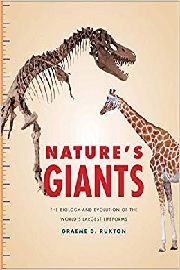Nature’s Giants: The Biology and Evolution of the World’s Largest Lifeforms

Graeme D. Ruxton
Yale, £24.99
It is often asked whether humans would be better placed to fend off attack from one horse-sized duck or one hundred duck-sized horses. Nature’s Giants does not provide an answer to this particular question, but it gives a good indication of why it is a nonsensical thing to ask. Within, Graeme D. Ruxton has provided an extremely broad if not especially deep survey of the largest animals and plants that live or have ever lived on our planet, covering everything from sauropods to seeds.
Though the numerous illustrations and pictures (of varying elucidative value) provide moments of unquenchable biological wanderlust for species past, the strength of this book lies in the why rather than the what. Why do we not get larger insects, for example, and what would happen to them if we did? Why are there so few species of big animals, and why do so many of them evolve deep at sea or on isolated islands? Why, in fact, would a horse-sized duck be a lumbering abomination that would struggle to breathe, let alone fly or attack humans? In scampering to cover so much ground, there are a few inaccuracies, but the main issue this book faces is audience.
Not in-depth or specific enough for the committed student, not beautiful enough for a coffee table, my guess is that the ideal readers are the young and scientifically precocious. For them, this book certainly provides much to be pored over and enthused by, if more as a springboard to further enquiries than anything more substantial.
D. Cornish


